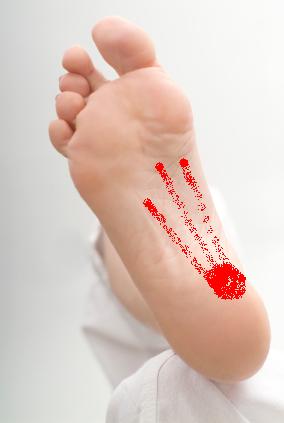Plantar Fasciitis Treatment
Plantar fasciitis is a very common condition and there are many different ways to treat it effectively. For those unfamiliar with plantar fasciitis, it is a painful condition that causes pain in the bottom of the foot. Usually, it is present in the heel and spreads into the soft tissue through the arch and bottom of the foot. It usually starts for no apparent reason and can be stubborn if left untreated.
How Common is Plantar Fasciitis?
Plantar fasciitis is a very common complaint and we are asked questions about it quite frequently. It is said to affect 10% of adults and people of all athletic abilities, so there’s a good chance you’ve either experienced this condition yourself or you know someone who has. Rupture of the plantar fascia is a relatively rare condition (when compared to plantar fasciitis) but the two conditions do share an interesting relationship…
Tear of the Plantar Fascia
The plantar fascia is a soft tissue structure on the bottom of your foot, running from the heel toward your toes. The movement of bringing your toes toward your shins puts a stretch on this tissue. Although relatively rare, the plantar fascia can be ruptured. Rupture of the plantar fascia most commonly occurs with one event. At the time of injury, the person will usually hear a “popping” noise and immediate pain.
Diagnosis of Plantar Fascia Rupture
There is usually an inability to perform a one-leg calf raise and bruising on the bottom of the foot. X-rays can be helpful in determining if there is an associated fracture of the calcaneus. A 2004 study published in the American Journal of Sports Medicine found that 17 of 18 cases of plantar fascia rupture had prior symptoms of plantar fasciitis. Perhaps more interesting, is that numerous studies have found a relationship between rupture of the plantar fascia and prior treatment with corticosteroid injection.
Treatment of Plantar Fasciitis and its Relationship to Rupture
– Leach et al; 6 ruptures studied / 5 had prior injection in the plantar fascia.
– Sellman; 37 ruptures studied / all 37 patients had prior injection to the plantar fascia.
– Acevedo et al; 51 ruptures studied / 44 patients had prior injection to the plantar fascia.
– Saxena et al; 18 ruptures studied / 4 patients had prior injection to the plantar fascia.
Corticosteroid Injection for Plantar Fasciitis
The proposed explanation for increased rupture is that the corticosteroid injection in the plantar fascia actually weakens the tissue. When this is followed by a rapid stretching of the plantar fascia (usually during athletic activity) rupture can occur. Keep in mind that rupture of the plantar fascia is rare and treatment for plantar fasciitis with corticosteroid injection may be a viable option for many people.
Conservative Treatment for Plantar Fasciitis
At Burlington Sports Therapy, we recommend an approach that uses one or a combination of treatment approaches. Active Release Technique (ART), Graston Technique, Laser Therapy (Cold Laser Therapy or Low Intensity Laser Therapy) and custom foot orthotics have all shown themselves as being effective ways to treat plantar fasciitis.
Active Release Technique for Treating Plantar Fasciitis
Active Release Technique or “A.R.T.” is a very popular soft tissue treatment approach that has a reputation for resolving injuries rapidly. It is utilized by many professional athletes and is performed all over the world on a daily basis. It has a unique ability to distinguish between different muscles and tissues and breakdown areas of dysfunctional “scar tissue”. The process of treatment involves gently moving the patient through different movements specific to different muscles. At the same time, the practitioner holds the muscle and assists in the scar tissue removal.
Graston Technique for Treating Plantar Fasciitis
The Graston Technique involves the use of six different stainless steel tools that are shaped for different areas of the body. It is very effective at removing scar tissue from dysfunctional soft tissues, especially in areas like the plantar fascia on the bottom of the foot.
Laser Therapy for Plantar Fasciitis
Laser therapy has become very popular in recent years due to its ability to rapidly resolve many conditions. Plantar fasciitis is one of these conditions. Laser therapy (also commonly called cold laser therapy or low intensity laser) assists the body’s natural healing process of cell regeneration. The stimulation of dysfunctional tissue using the laser is a painless way to recover from injuries, especially a condition like plantar fasciitis.
Orthotics for Plantar Fasciitis
Custom foot orthotics are made from casts of your feet. They are made to accommodate any foot abnormalities or biomechanical dysfunctions that may have contributed to plantar fasciitis. They assist the foot by stabilizing the arch and allowing for proper mechanics during standing and walking. They are also known to improve foot, ankle, knee and hip mechanics as well as improving chronic cases of lower back pain.
For further information or to schedule an appointment – 905.220.7858
email – info@burlingtonsportstherapy.com
References
Delitto S, Dewitt J, Ferland A, Fearon H, MacDermaid J, McClure P, Shekelle P, Smith AR, Torburn L. Plantar fasciitis – APTA clinical guidelines. Journal of Orthopaedic & Sports Physical Therapy 2008; 38(4): A1-A18.
League A. Current concepts review: plantar fasciitis. Foot & Ankle International 2008; 29(3): 358-366.
Saxena A, Fullem B. Plantar fascia ruptures in athletes. The American Journal of Sports Medicine 2004; 32(3): 662-665.
Disclaimer – https://burlingtonsportstherapy.com/blog/disclaimer/









